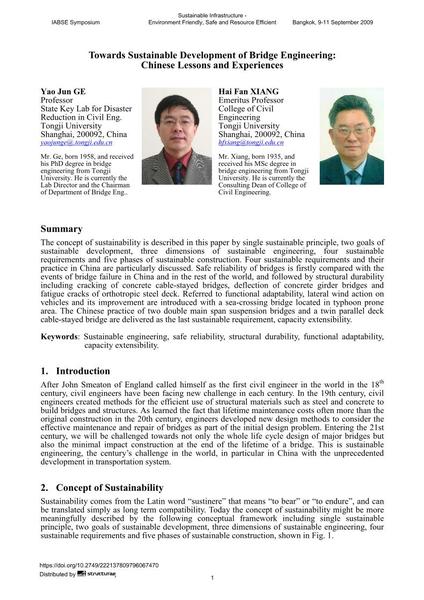Towards Sustainable Development of Bridge Engineering: Chinese Lessons and Experiences

|
|
|||||||||||
Bibliographic Details
| Author(s): |
Yao Jun Ge
Hai Fan Xiang |
||||
|---|---|---|---|---|---|
| Medium: | conference paper | ||||
| Language(s): | English | ||||
| Conference: | IABSE Symposium: Sustainable Infrastructure - Environment Friendly, Safe and Resource Efficient, Bangkok, Thailand, 9-11 September 2009 | ||||
| Published in: | IABSE Symposium Bangkok 2009 | ||||
|
|||||
| Page(s): | 19-28 | ||||
| Total no. of pages: | 9 | ||||
| Year: | 2009 | ||||
| DOI: | 10.2749/222137809796067470 | ||||
| Abstract: |
The concept of sustainability is described in this paper by single sustainable principle, two goals of sustainable development, three dimensions of sustainable engineering, four sustainable requirements and five phases of sustainable construction. Four sustainable requirements and their practice in China are particularly discussed. Safe reliability of bridges is firstly compared with the events of bridge failure in China and in the rest of the world, and followed by structural durability including cracking of concrete cable-stayed bridges, deflection of concrete girder bridges and fatigue cracks of orthotropic steel deck. Referred to functional adaptability, lateral wind action on vehicles and its improvement are introduced with a sea-crossing bridge located in typhoon prone area. The Chinese practice of two double main span suspension bridges and a twin parallel deck cable-stayed bridge are delivered as the last sustainable requirement, capacity extensibility. |
||||
| Keywords: |
sustainable engineering safe reliability structural durability functional adaptability capacity extensibility
|
||||
